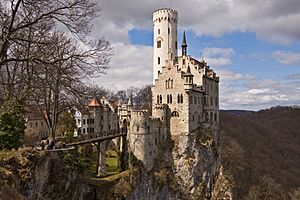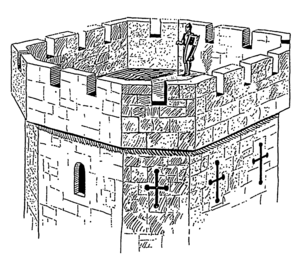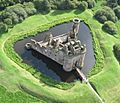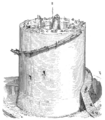Castle facts for kids
A castle is a strong, fortified building that was built in Europe and the Middle East during the Middle Ages. The word "castle" comes from the Latin word castellum, which means "fortified place."
Castles were usually private homes for a lord or noble. This made them different from a fortress, which was just for fighting, or a walled town, which protected everyone. For about 900 years, castles were built in many different shapes and sizes.
Castles first appeared in Europe in the 9th and 10th centuries. They helped control the areas around them. Castles could be used to attack enemies or to protect people from danger. They were also a symbol of power. A castle showed everyone who was in charge and helped control the people and roads nearby.
Many early castles were built using earth and wood. Later, their defenses were often rebuilt with strong stone. At first, castles often used natural features like hills for protection and didn't have tall towers. But by the late 12th and early 13th centuries, castles became much larger and more complex.
When gunpowder arrived in Europe in the 14th century, it didn't stop castle building right away. However, by the 15th century, cannons became powerful enough to break through thick stone walls. New castles were still built, but they needed new ways to protect against guns. These new designs often made castles uncomfortable to live in. Because of this, people stopped building true castles. Instead, they built large country houses or military forts. From the 18th century, people started building castles again because they liked the old Gothic architecture. But these new castles were not used for fighting.
Contents
What is a Castle?
The Meaning of the Word

The word castle comes from the Latin word castellum. This word is a smaller version of castrum, which means "fortified place." Words like the French château, Spanish castillo, and Italian castello also come from castellum.
The word "castle" became part of the English language after the Normans arrived. It described this new type of building. However, these words can mean different things today. For example, a French château can simply be a large country house on an estate.
Key Features of a Castle
Most people agree that a castle is "a private fortified residence." This means it was a strong, protected home for one family or ruler. This is different from older fortifications like walled cities, which protected everyone. Castles were built and owned by lords, either for themselves or for their king.
Castle Defenses
A castle's main defense was its strong wall. Walls stopped attackers from breaking in. The rooms inside the castle often had small holes, called arrowloops, cut into the walls. Soldiers could fire arrows or shoot through these holes without being hit.
The main way to get into a castle was through a gate. A gate was usually made of wood with a heavy metal gate behind it. It had two purposes: to let friends in or out, and to keep enemies out. If attackers got past the first gate, objects could be dropped through holes called murder holes in the upper part of the gate. The gate was always one of the most protected parts of a castle.
Some castles also had moats. These were ditches filled with water that went all around the castle. The only way to get in was over a drawbridge. A drawbridge was a heavy wooden door that could be pulled up by chains to protect the main gate. It could also be lowered to act as a bridge over the moat.
Sometimes, soldiers attacking a castle tried to knock down the walls or dig tunnels under them. A siege was when attackers just waited outside the castle. If the people inside ran out of food and water, they would have to surrender. A siege could last for many months if the castle had enough supplies.
Castles were built for defense until about 500 years ago, at the end of the Middle Ages. After that, people still built very large stone buildings that looked like castles. But these new buildings had bigger windows and more fireplaces. They were much more comfortable inside. They were really just very large houses. When these buildings were made to be homes instead of fortresses, the word 'Castle' was often put in their name. For example, Castle Oliver in Ireland was built about 150 years ago. It has 215 windows and 65 chimneys, plus many bedrooms. It is very bright inside because it was built for parties, not for keeping out soldiers.
Many castles today are very beautiful and open to the public. You can sometimes see old furniture, clothes, armour, musical instruments, carpets, cannons, and other weapons that belonged to the people who lived there. Some castles even have legends of ghosts! Some had very famous owners, like the "mad" King Ludwig of Bavaria. A very few castles are still lived in by the families who built them. Many others have become hotels or museums.
Castles seem romantic and mysterious to us now. But they were often cold, dark, and damp places to live. Their walls were very thick, sometimes 12 feet (4 meters) or more. This meant they never really got warm. Their windows also had no glass in them. Castles might have been safe, but they weren't very comfortable homes!
Images for kids
-
Dating back to the early 12th century, the Alcázar of Segovia is one of the most distinctive castles in Europe.
-
Built in 1385, Bodiam Castle in East Sussex, England, is surrounded by a water-filled moat.
-
The Norman White Tower, the keep of the Tower of London, shows all uses of a castle: city defense, a home, and a safe place in times of trouble.
-
Windsor Castle in England was started as a fort during the Norman Conquest. Today, it is one of the main official homes of Queen Elizabeth II.
-
São Jorge Castle in Lisbon, Portugal, with a bridge over a moat.
-
The wooden fences on top of mottes were often later replaced with stone, like this example at Château de Gisors in France.
-
A courtyard of the 14th-century Raseborg Castle in Finland.
-
Beaumaris Castle in Anglesey, North Wales, with outer walls between lower towers, and higher inner walls between higher inner towers.
-
Caerlaverock Castle in Scotland is surrounded by a moat.
-
Daorson, Bosnia, built around a very old fortified settlement (from about 17th/16th century to the end of the Bronze Age). It is surrounded by huge cyclopean walls from the 4th century BCE.
-
Borġ in-Nadur fort in Malta, built during the Tarxien phase and used until the Bronze Age.
-
The Bayeux Tapestry shows one of the earliest pictures of a castle. It shows attackers of the Château de Dinan in France using fire, which was a big danger to wooden castles.
-
The gatehouse to the inner part of Beeston Castle in Cheshire, England, was built in the 1220s. It has an entrance between two D-shaped towers.
-
Krak des Chevaliers in Syria is a concentric castle with both rectangular and rounded towers. It is one of the best-preserved Crusader castles.
-
The design of Edward I's Harlech Castle (built in the 1280s) in North Wales was influenced by his experiences in the Crusades.
-
The northern walls of the Gran Castello in Gozo, Malta, were built in the 15th century.
-
Corvin Castle in Transylvania (built between 1446 and 1480) was one of the biggest in Eastern Europe at that time.
-
Castle De Haar, Utrecht, Netherlands.
-
The angled bastion, used in Copertino Castle in Italy, was developed around 1500. It allowed the creation of artillery forts that eventually took over the military role of castles.
-
Neuschwanstein is a 19th-century castle built by Ludwig II of Bavaria. It was inspired by the romanticism of the time and looks like an old Romanesque castle.
-
A 19th-century picture by Eugène Viollet-le-Duc showing the building of the large tower at Coucy Castle in France. It shows scaffolding and masons working. The holes in the wall show where the scaffolding was placed earlier. The tower was blown up in 1917.
-
God Speed! by Edmund Blair Leighton, 1900: a Victorian painting of a lady giving a favor to a knight before battle.
-
Srebrenik Fortress in Srebrenik, Bosnia: its hard-to-reach location, with only a narrow bridge over a deep canyon, provides excellent protection.
-
Almourol Castle in Portugal, which stands on a small island in the Tejo River.
-
Tavastia Castle in Hämeenlinna, Finland, one of the northernmost castles in Europe. The exact date it was built is not clear, but it is known to have been built in the late 13th century. It was first mentioned in documents in 1308. It was built close to Lake Vanajavesi.
-
An early 13th-century drawing by Matthew Paris showing warfare of the time. It includes castles (here Lincoln Castle), crossbowmen, and mounted knights.
-
A reconstructed trebuchet at Château des Baux in Bouches-du-Rhône in the south of France.
See also
 In Spanish: Castillo para niños
In Spanish: Castillo para niños





































